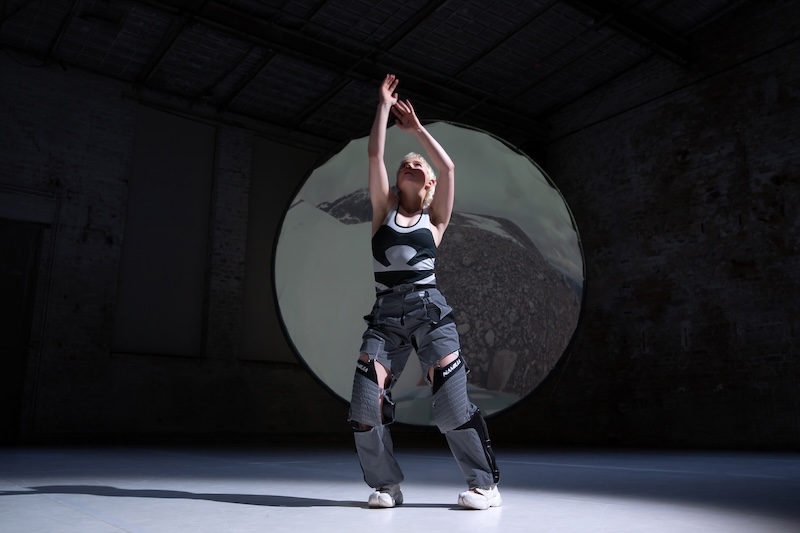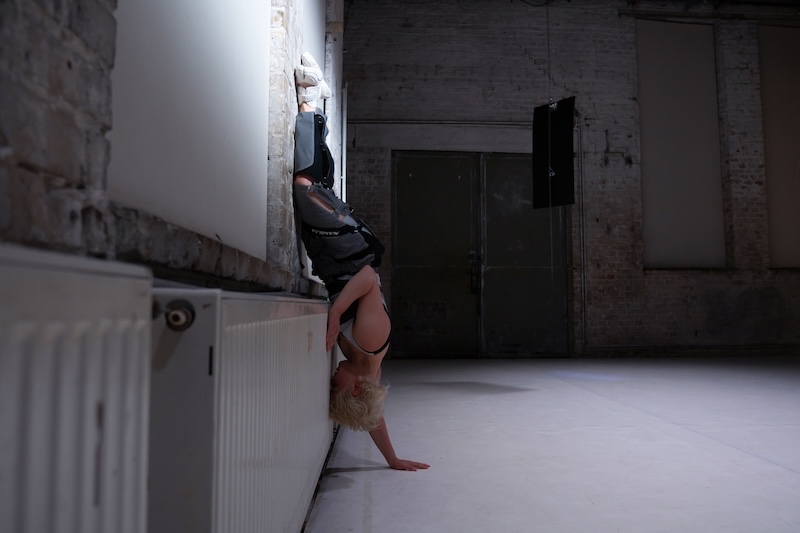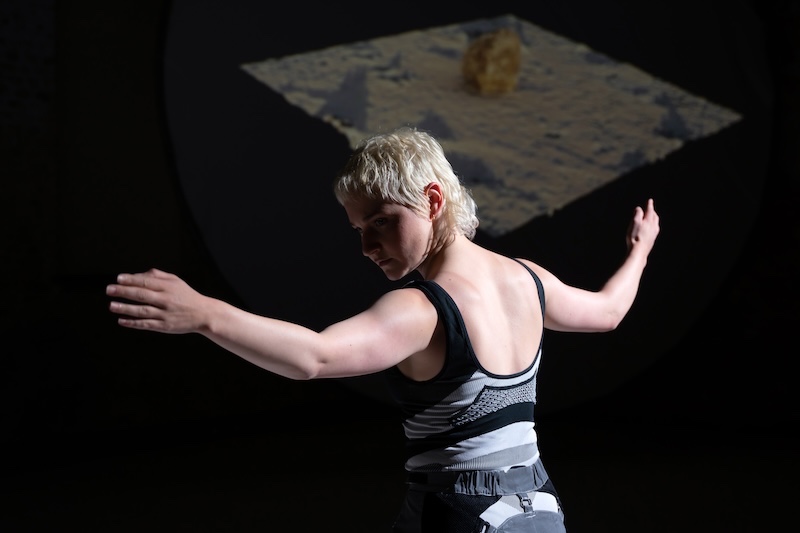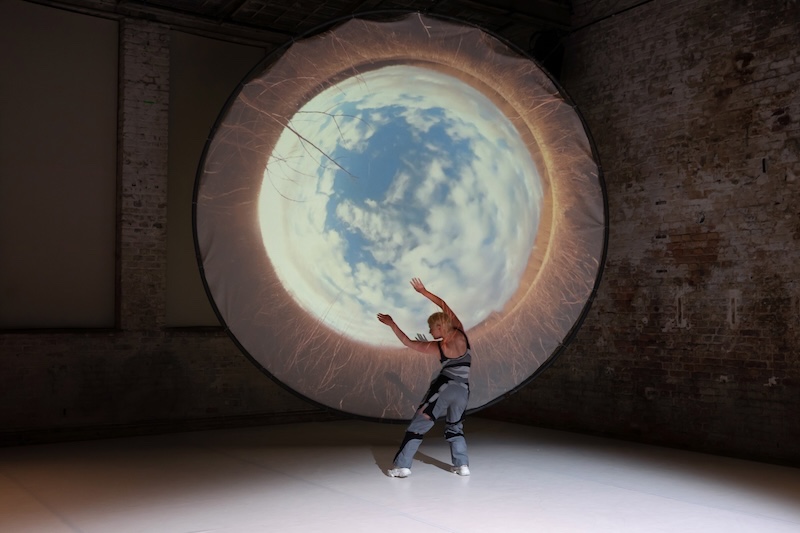by Beatrix Joyce // May 6, 2024
This article is part of our feature topic Habitat.
As part of the research for her recent performance work ‘screen play,’ choreographer Hannah Schillinger visited 12 “wounded landscapes” across Germany and the Czech Republic. From a burned down forest in Sachsen (Waldbrandgebiete sächsische Schweiz) to a desert in Brandenburg (Lieberoser Wüste), each habitat showed traces, or scars, of human intervention. Schillinger sought to enter these locations from the vantage point of the sensing body; as a dancer, she took a somatic approach to exploring and listening, to co-existing with these places, often deemed dangerous or labelled as “no-trespassing” zones. Her desire was to allow herself to be moved by these sites, and upon returning to the city, mould what she had discovered and documented into her stage piece ‘screen play,’ first premiered at Dock 11 in June 2023. I spoke with Schillinger about her research, creation process and choreographic practice, and what lasting impressions these habitats left on her.

Hannah Schillinger: ‘Screenplay,’ 2024 // Photo by Alicja Hoppel
Beatrix Joyce: In your work ‘screen play,’ an explorer guides us through various landscapes, both physically on stage and virtually on a screen. Can you tell us about the process behind the piece: which sites did you go to and what drew you to them?
Hannah Schillinger: The first place I went to was the Müggelsee lake close to Berlin. The water quality of the lake has changed a lot in recent years, and I realized that you don’t need to travel far to find “wounded” habitats; we are surrounded by sites that carry scars from the climate crisis. In some sites, what makes them “wounded” is more visible or tangible than in others. For example, when I visited the glacier in Bavaria (Gletscher Zugspitze), it was clear that the ice was melting. It nonetheless remains a prime tourist attraction for skiing, and that narrative was clearly woven into the landscape. What felt very destroyed and dead was a coal mine I visited in Lausitz (Braunkohle Tagebau Welzow Süd), because it had clearly been rolled over by machines and galvanized by the coal-mining industry. Some plants had started to grow back; plant life always finds a way to survive. Just like at Fresdorfer See, a dried-out lake in Brandenburg, where new species, such as wild boars and birds, have made it their habitat and it has morphed into a new ecosystem. It allowed me to see that regeneration is also possible.
Sometimes I would meet thresholds that I was told not to cross. For example, at the Küste Lubmin in Vorpommern, a geopolitical site where the Northstream gas line from Russia was sabotaged, there were cordoned off zones with forbidden entry, under strict surveillance. In these cases, I would seek out a spot where I could just be. I tried to forget the site’s context and shift towards a more sensorial existence within it. I had a ritual; each time I arrived at a new site, I’d find somewhere to leave my stuff and then I’d change into my explorer costume (designed by my collaborator Louis Caspar Schmitt) that included a helmet with a 360° camera mounted on top. From there, I would start to move, paying attention to the space, its textures, its colours and how it made me feel.

Hannah Schillinger: ‘Screenplay,’ 2024 // Photo by Alicja Hoppel
BJ: Yes, I found your costume to be really striking. It helped to create a character. I found myself wondering: who is this explorer? What do they want? Do they just happen to be there, or are they on a mission to uncover secrets or wrongdoing?
HS: Well, initially, I felt like an intruder, as I was entering a place that wasn’t my natural habitat. So, I sought to enter by listening, by being perceptive. I wanted to learn about these places by meeting them, physically. From my encounters, micro-narratives, fictions, associations emerged; being an astronaut on Earth, sci-fi imaginaries…To be honest, I wasn’t that interested in character development. I was interested in understanding how in these places there are always both destructive and regenerative forces at play. Forces that are caused both by humans and by nature, that move through them and act on them. I was curious about studying these forces of transformation in relation to the human body and that’s why I felt it was needed to bring the human body directly into dialogue with these locations.
I considered “the explorer” less as a character and more as a tool for perception. They don’t impose themselves on these landscapes, but they’re not completely passive either. Like an animal, or a post-human creature… It’s an ambiguous being, an attempt at dissolving our human need for agency and being in conversation with our environment through a different kind of language, based on embodiment.

Hannah Schillinger: ‘Screenplay,’ 2024 // Photo by Alicja Hoppel
BJ: I immediately empathized with this being that was going out to these places on their own. I found there was a bravery, and a solitude, in that. Was it a lonely experience for you?
HS: These day trips to different places became a ritual for me. I would always go alone. I don’t know if I could have gone with anybody else because it was quite an intimate experience. I had decided to care about these places, that were otherwise being forgotten or ignored. Going there alone helped me to have a heightened sensitivity towards and a vulnerability in meeting these places. Afterwards, I would write and digest the encounter so that it really settled into my body archive. I needed this time alone to leave the social realm and enter into this “other” body-mind state.
BJ: How did you go about creating an “artistic” habitat out of these different habitats that you had visited? Which media did you use?
HS: From the beginning, it was an interdisciplinary process. I collaborated with a video artist (Louis Caspar Schmitt), sound artist (Vagelis Tsatsis) and lighting designer (Vito Walter) on the respective media of video, sound and light. I collected relics from the sites, such as stones and bits of trash. Then I had the recordings and digital documents from my travels. I brought all of these to the studio, along with my somatic experiences, my body memory, from which I developed the choreographic material. I sought to revisit these places with my body and condense them into choreographed micro-worlds. I then situated each of these micro-worlds, each of the seven places, as “zones” in the room; this created a kind of cartography on stage. During the piece, I revisit each of the locations I explored, diving back into my somatic experience of them along a kind of dream logic. I like to think I am calling to these sites, creating links between them and channeling them through my body.
I was inspired by queer feminist quantum physicist Karen Barad, who says that the immaterial has agency. I worked on puzzling my impressions together in the space, and being in dialogue with the objects, fictions and imaginations that surrounded my body. The habitats I went to existed already and continue to exist without me. But my body becomes the medium with which I can make them visible.

Hannah Schillinger: ‘Screenplay,’ 2024 // Photo by Alicja Hoppel
BJ: There were moments in the choreography where you seemed wounded, perhaps mirroring the wounded places you had visited. Was this an emotional response to the landscapes, a way to empathize with them?
HS: Throughout the creation process emotions played a large role; grief, anger, fear… I had a lot to process. In this way, the choreography shifts between sensorial, emotional and reflexive layers. I felt that empathizing with the landscape worked the most through the sensorial. I felt the emotional layers to be part of the human response: realizing what we have done to the landscape and how we consider it now. But, fundamentally, I don’t know what a tree feels when it falls down. I can relate it to my own experience of being wounded, and thereby approximate it in the realm of human experience. I used trauma release (TRE), in which uncontrollable shivering and shaking is thought to be a means to resolve trauma, in my practice. I looked at shock states, the anger and frustration of the activist, the weight of grief, care. Nature doesn’t care. Some of the places I went felt heavy, but others—for example the dried-out Fresdorfer See—had just become something else: it felt so peaceful to be there. Nature will continue to live and flourish even when we’re gone. We’re harming ourselves the most. On stage, I am trying to shed these layers and make myself open and available for the feelings, thoughts and sensations that I discovered in these places to pass through me. It’s up to the audience to decide whether they empathize. It’s an open invitation to join me on my travels, to encounter these habitats and ourselves within them.


























